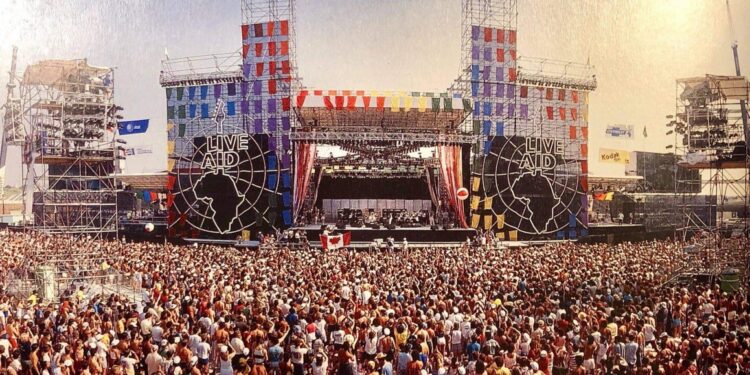Live Aid benefit concert marks 40 years since historic dual-venue fundraiser
On 13 July 1985, the world witnessed one of the most ambitious charitable events in music history as Live Aid brought together performers at Wembley Stadium in London and JFK Stadium in Philadelphia simultaneously. The benefit concert, organised by Bob Geldof and Midge Ure, raised vital funds for Ethiopian famine relief whilst creating a global moment of unity that reached an estimated 1.5 billion television viewers worldwide.
Live Aid was conceived as a continuation of the fundraising movement that began with the Band Aid single “Do They Know It’s Christmas?” in 1984. The organisers recognised that a single concert venue would not be sufficient to accommodate the scale of their ambitions, leading to the groundbreaking decision to stage simultaneous events across two continents.
The London show at Wembley Stadium was officially opened by Prince Charles and Princess Diana, lending royal endorsement to the humanitarian cause. Status Quo kicked off the proceedings, marking the beginning of what would become a 16-hour musical marathon that featured some of the biggest names in popular music.
The Philadelphia component at JFK Stadium served as the American counterpart, ensuring that the event could capture audiences on both sides of the Atlantic during prime viewing hours. The Philadelphia venue attracted crowds of up to 100,000 people, creating an electric atmosphere that matched the energy being generated simultaneously in London.
Billed as the “Global Jukebox,” Live Aid served as an international fundraising platform designed to bring relief to those suffering from the Ethiopian famine. The dual-venue format allowed for continuous programming, with performances alternating between London and Philadelphia to maintain momentum and maximise television coverage across different time zones.
The technical achievement of coordinating live broadcasts between two venues separated by thousands of miles was remarkable for its time. The satellite link-up technology enabled real-time communication between the shows, creating a truly global experience that demonstrated the power of music to transcend geographical boundaries.
The concert raised millions of dollars for famine relief in Ethiopia, though the exact figure has been subject to various estimates over the years. Beyond the immediate financial impact, Live Aid established a template for future benefit concerts and demonstrated how the music industry could mobilise for humanitarian causes.
The event’s legacy extends beyond its charitable achievements. Live Aid is often cited as a pivotal moment in the development of the modern benefit concert format, influencing subsequent events such as Farm Aid, Comic Relief, and more recent global fundraising initiatives. The concept of simultaneous venues has been replicated in various forms, proving the enduring relevance of the Live Aid model.
Live Aid represented one of the greatest events ever staged in Philadelphia’s history, whilst the London component at Wembley Stadium remains one of the most celebrated concerts in British music history. The dual-venue approach allowed both cities to participate in a moment of global significance, creating lasting memories for attendees and viewers alike.
Forty years later, the impact of Live Aid continues to resonate within the music industry and charitable sectors. The event demonstrated that popular music could serve as a powerful vehicle for social change, inspiring countless artists and organisers to use their platforms for humanitarian purposes. The success of the dual-venue format proved that ambitious logistical challenges could be overcome when driven by a compelling cause.
REFH – newshub finance


Recent Comments